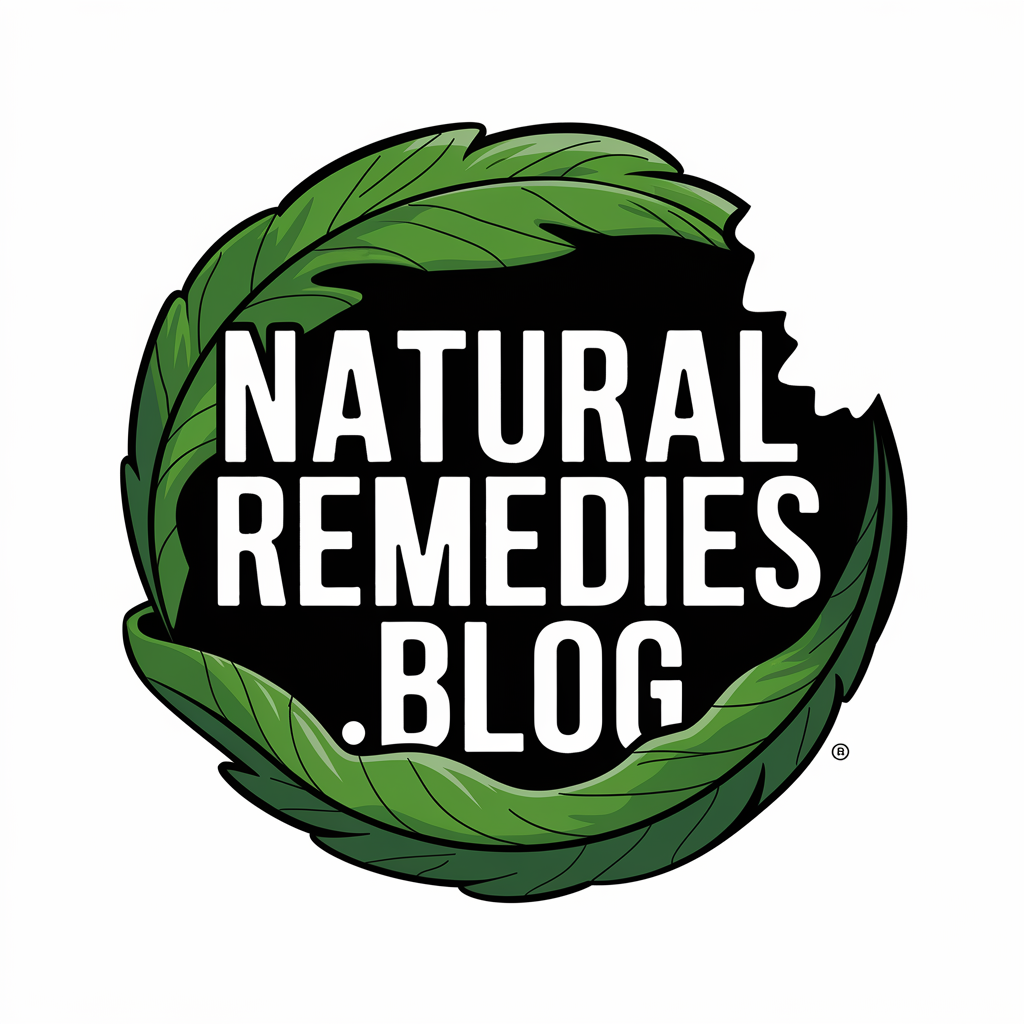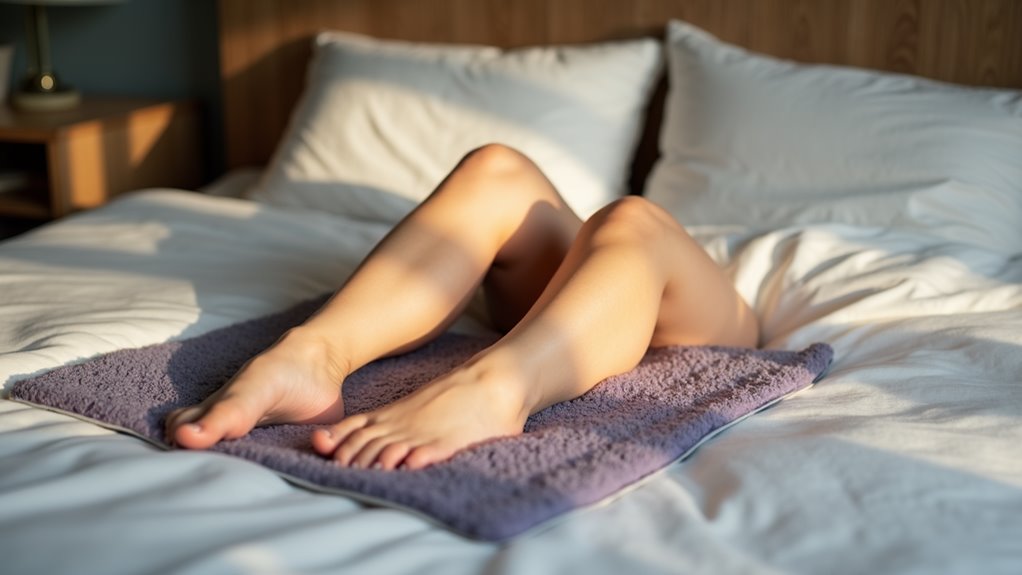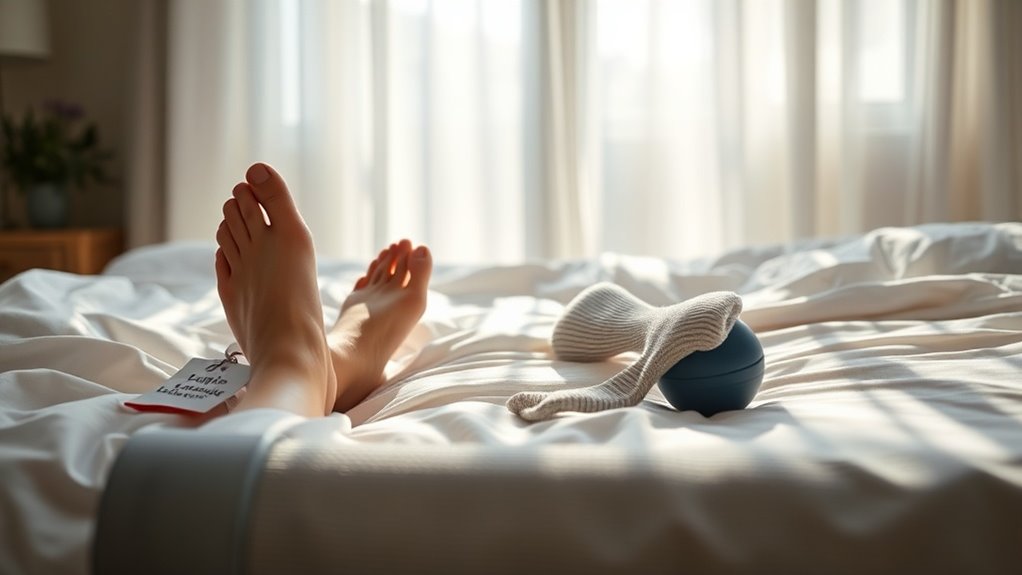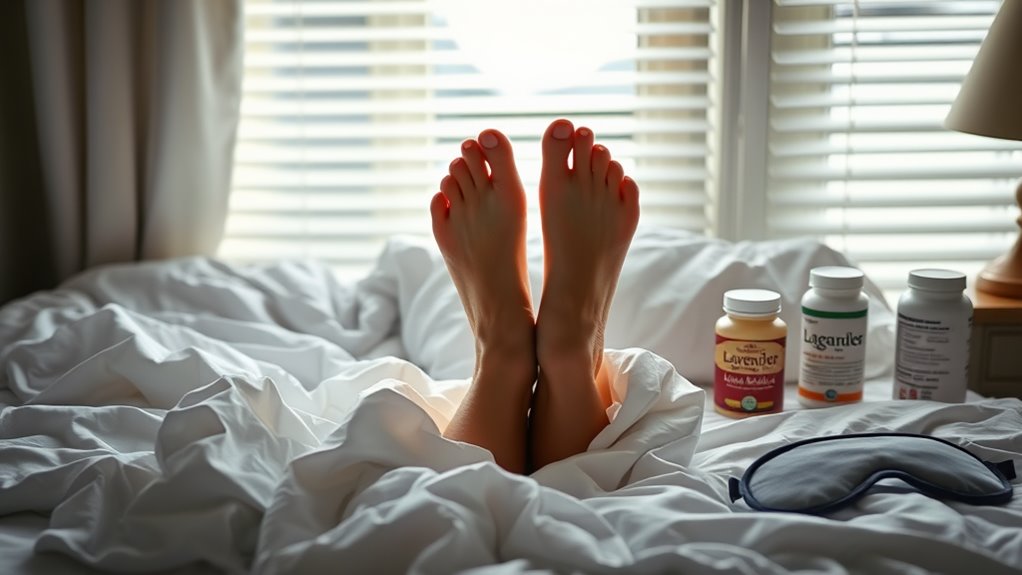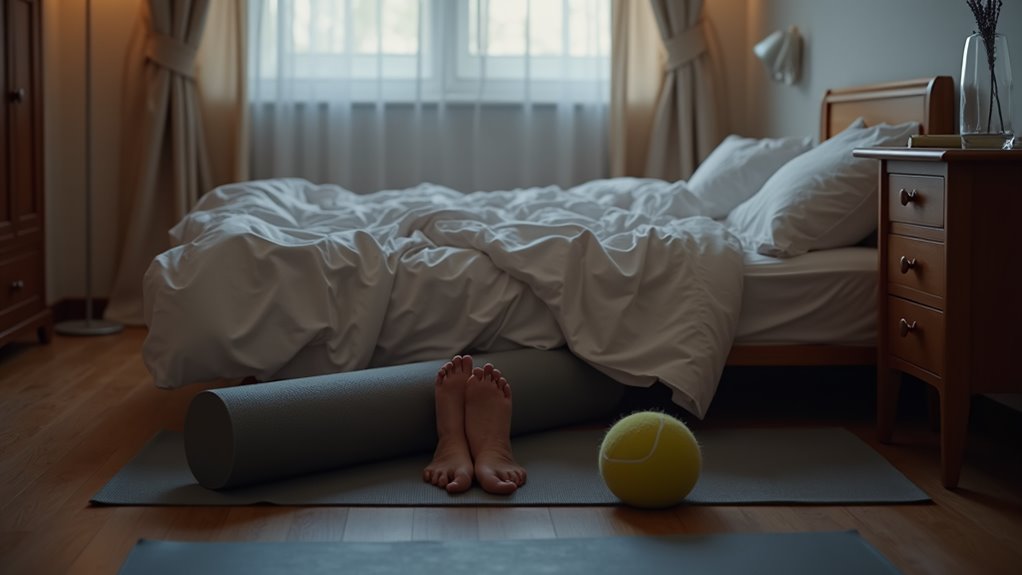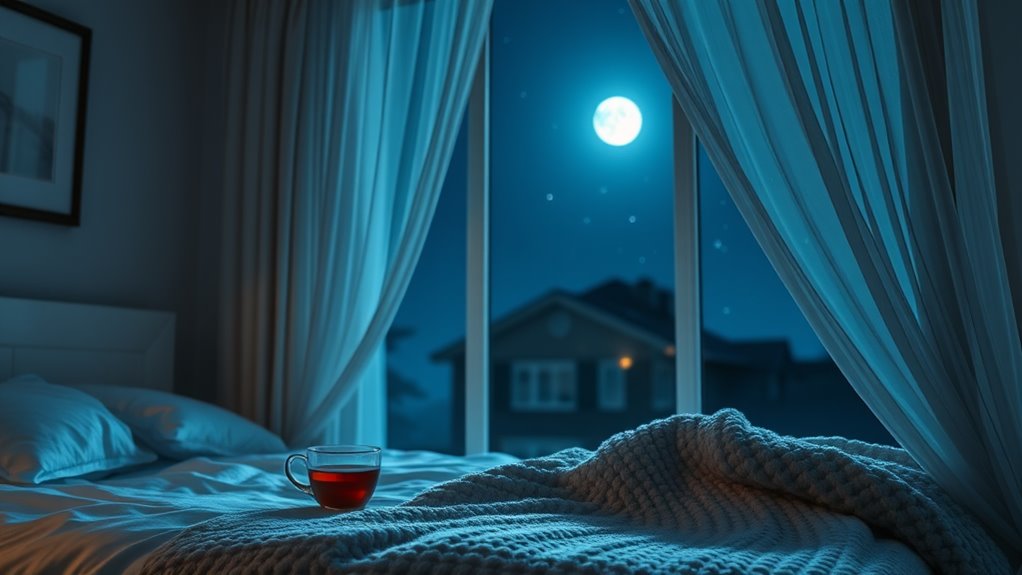This Restless Leg Remedy Helped Me Finally Sleep Through the Night
You’ll find effective relief from Restless Leg Syndrome through a specific combination of natural remedies and lifestyle adjustments. Start by taking magnesium and iron supplements (if deficient), practice gentle yoga before bed, use weighted blankets, and maintain a cool bedroom temperature of 65-68°F. Compression socks, precise medication timing, and 10 minutes of targeted stretching complete this evidence-based protocol. Our comprehensive approach reveals the exact steps to transform your nights.
My Lifelong Battle With Restless Leg Syndrome
Since developing symptoms in my early teens, I’ve struggled with the relentless urge to move my legs during periods of rest. Doctors initially dismissed my complaints as growing pains, but the sensations persisted – a constant crawling, tingling, and pulling beneath my skin that intensified at night.
Over the years, I’ve tried countless restless leg remedies: prescription medications, lifestyle changes, supplements, and alternative therapies. Some provided temporary relief, while others proved ineffective.
The condition significantly impacted my sleep quality, causing daytime fatigue and affecting my academic and professional performance. Understanding that iron deficiency anemia could be triggering my symptoms finally led me to explore more targeted treatment options.
The Breaking Point: When Sleepless Nights Became Unbearable
After months of fragmented sleep and growing desperation, my breaking point arrived during a crucial work presentation.
Midway through, I couldn’t focus on my slides as the familiar tingling and urge to move overwhelmed my legs. I stumbled through the remainder, fighting exhaustion and discomfort.
That night, like countless others, I paced my bedroom at 3 AM, my muscles refusing to rest.
My productivity had plummeted, relationships suffered, and anxiety levels soared. Blood tests showed low iron levels, and my doctor confirmed severe RLS.
It was time to explore serious treatment options.
Like many middle-aged women, I discovered RLS symptoms tend to be more severe and frequent in females.
Understanding RLS: Symptoms and Triggers
If you’re experiencing an irresistible urge to move your legs, especially during periods of rest, you may be dealing with Restless Legs Syndrome (RLS), a neurological condition that affects up to 10% of adults.
RLS risk factors include iron deficiency, pregnancy, certain medications, and genetic predisposition, while common warning signs include sensations described as crawling, pulling, or tingling in the legs.
Your daily habits, such as caffeine consumption, irregular sleep patterns, and lack of exercise, can significantly impact the frequency and intensity of RLS symptoms.
Vitamin C absorption alongside iron-rich foods can help improve symptoms in those with iron deficiency-related RLS.
Common RLS Warning Signs
Do you experience an irresistible urge to move your legs, especially during periods of rest? This primary symptom of Restless Leg Syndrome (RLS) often appears alongside other warning signs that can significantly impact your quality of life.
| Warning Signs | Common Triggers |
|---|---|
| Crawling sensations | Evening hours |
| Leg discomfort | Extended sitting |
| Sleep disruption | Caffeine intake |
| Daytime fatigue | Stress levels |
Your symptoms may worsen in the evening or during long periods of inactivity. Many people describe the sensations as tingling, pulling, or aching. These feelings temporarily improve with movement but return when you’re still, making it challenging to maintain restful sleep.
Key RLS Risk Factors
While recognizing RLS symptoms helps with diagnosis, certain factors can increase your likelihood of developing this neurological condition.
Research has identified several key risk factors that make you more susceptible to RLS:
-
Genetics play a significant role, with 40% of cases showing a family history of the condition
-
Iron deficiency or anemia, even at levels considered borderline normal, can trigger RLS symptoms
-
Pregnancy, particularly during the third trimester, often leads to temporary RLS
-
Chronic health conditions like diabetes, peripheral neuropathy, and kidney disease frequently correlate with RLS development
Daily Habits Affecting RLS
Certain everyday habits and lifestyle choices can significantly impact the frequency and intensity of your RLS symptoms. Consuming caffeine, alcohol, or nicotine, especially in the evening hours, can trigger or worsen symptoms.
Irregular sleep patterns and lack of exercise also contribute to RLS flare-ups. Your medications may play a role too. Antihistamines, antidepressants, and anti-nausea drugs can exacerbate RLS symptoms.
Extended periods of inactivity, like long car rides or desk work, often intensify discomfort. Even your evening routine matters – watching TV or using electronic devices before bed can disrupt your circadian rhythm and worsen RLS.
Traditional Treatments That Failed Me
If you’ve tried traditional RLS treatments, you’re likely familiar with the frustrating side effects of dopaminergic medications, including nausea, dizziness, and the potential for augmentation where symptoms actually worsen.
Physical therapy exercises and stretching routines, while promising in theory, often fail to provide meaningful relief for moderate to severe RLS symptoms.
Even when precisely following prescribed protocols, these conventional approaches left many patients, including myself, searching for more effective solutions.
While vitamin D deficiency often underlies RLS symptoms, standard treatments rarely address this crucial nutritional factor.
Medications Caused Side Effects
Before finding natural remedies for my restless leg syndrome, I tried several traditional medications that caused problematic side effects.
While these prescription drugs initially helped control my RLS symptoms, their adverse effects became increasingly difficult to manage over time.
Common side effects I experienced included:
- Severe daytime drowsiness from dopaminergic medications
- Nausea and dizziness from anticonvulsant drugs
- Memory issues and confusion with benzodiazepines
- Worsening symptoms due to augmentation with long-term use
These medication-induced complications led me to explore alternative treatments that wouldn’t compromise my daily functioning or create additional health concerns.
Physical Therapy Fell Short
Physical therapy, widely recommended as a first-line treatment for RLS, proved ineffective despite months of dedicated sessions and exercises.
You’ll find that stretching, massage, and targeted muscle strengthening often fail to address the neurological root of RLS symptoms.
Your therapist may have focused on improving circulation and reducing muscle tension in your legs, yet these approaches don’t resolve the underlying dopamine imbalance that triggers the condition.
While some patients report temporary relief during sessions, you’re likely to experience symptom recurrence within hours.
The limitations of physical therapy highlight the need for more comprehensive treatment strategies.
Discovering the Natural Solution
While prescription medications can provide relief for restless leg syndrome (RLS), many sufferers prefer exploring natural alternatives first.
Studies have shown several promising natural solutions that effectively reduce RLS symptoms.
-
Magnesium supplements taken daily can decrease leg discomfort and improve sleep quality.
-
Iron supplementation, when prescribed by your doctor after blood testing, may resolve RLS symptoms if deficiency exists.
-
Regular yoga practice, particularly gentle stretching before bed, can minimize nighttime leg sensations.
-
Weighted blankets, typically 10-15% of body weight, help calm restless legs through deep pressure stimulation.
Gentle forward folds and other targeted yoga poses can provide immediate relief when symptoms flare up.
How This Remedy Works
These natural remedies target RLS through specific biological mechanisms in your body. They work by increasing dopamine production and regulating iron absorption, two critical factors in managing restless leg syndrome.
The herbs and minerals interact with your nervous system to reduce nerve excitability and muscle tension.
You’ll notice the effects as the compounds cross the blood-brain barrier, helping to normalize neurotransmitter levels that control leg movement.
The remedy’s anti-inflammatory properties also reduce tissue irritation around nerve endings, while magnesium and potassium components help regulate muscle contractions.
This multi-pathway approach addresses both the neurological and muscular aspects of RLS.
My New Nighttime Routine
Since incorporating this remedy into my evening schedule, I’ve developed a consistent routine that maximizes its effectiveness.
Following strict timing ensures optimal results for managing restless leg symptoms during sleep hours.
- Take the medication 45 minutes before bedtime with 8 oz of water
- Practice 10 minutes of gentle stretching, focusing on calves and hamstrings
- Keep bedroom temperature between 65-68°F (18-20°C)
- Use compression socks until getting into bed
This protocol has dramatically reduced nighttime leg movements and improved sleep quality metrics according to my sleep tracking data.
The remedy’s effectiveness depends on maintaining this precise schedule.
Changes in Sleep Quality and Daily Life
You’ll notice immediate improvements in your sleep quality after implementing these remedies for restless leg syndrome.
Your daily activities become more manageable as your nighttime rest improves, allowing you to maintain focus and accomplish tasks without the usual fatigue.
Sustained energy levels throughout the day represent one of the most significant benefits, replacing the previous cycle of exhaustion with consistent vitality.
Better Rest Each Night
Making positive changes to manage restless leg syndrome often leads to dramatic improvements in sleep quality and daily functioning.
You’ll notice significant benefits when you implement research-backed strategies consistently.
-
Track your symptoms in a sleep diary to identify triggers and patterns.
-
Create a calming bedtime routine that includes gentle stretching and relaxation techniques.
-
Maintain a cool, dark bedroom environment between 65-68°F for optimal rest.
-
Follow a consistent sleep schedule, going to bed and waking up at the same time.
These evidence-based approaches can help you achieve restorative sleep and reduce RLS symptoms that interfere with your rest.
Daily Activities Improved Dramatically
When restless leg symptoms diminish through proper management, your overall quality of life transforms dramatically. You’ll notice significant improvements in both daytime functioning and nighttime rest.
| Before Treatment | After Treatment |
|---|---|
| Difficulty concentrating | Enhanced focus |
| Low energy levels | Increased vitality |
| Mood swings | Emotional stability |
| Poor physical performance | Improved coordination |
With better sleep quality, you’ll experience enhanced cognitive performance, stable mood regulation, and increased physical stamina. Your work productivity rises as brain fog lifts, and you’ll find yourself more engaged in social activities. Exercise becomes more enjoyable and effective as your body maintains proper rest-activity cycles.
Energy Levels Stay Higher
Better sleep quality from managed restless leg symptoms leads to sustained energy throughout your day.
When your body achieves proper rest without leg discomfort interrupting your sleep cycles, you’ll notice significant improvements in your daily energy reserves.
- Mental alertness remains sharp from morning through evening hours
- Physical stamina increases for exercise and daily activities
- Reduced daytime fatigue means less reliance on caffeine and stimulants
- Emotional resilience improves due to balanced sleep-wake cycles
Your circadian rhythm normalizes as RLS symptoms decrease, allowing your body to maintain consistent energy levels instead of experiencing the typical afternoon crashes associated with disrupted sleep.
Tips for Maximizing the Remedy’s Effectiveness
To maximize the effectiveness of your restless leg remedy, you’ll need to follow several evidence-based strategies consistently.
Take the supplement at the same time each evening, ideally 1-2 hours before bedtime. Avoid caffeine after 2 PM, as it can interfere with the remedy’s absorption.
Maintain a regular exercise routine, but complete workouts at least 3 hours before sleep. Keep your bedroom temperature between 65-68°F and limit blue light exposure in the evening.
Stay hydrated throughout the day, but reduce fluid intake 2 hours before bed. If symptoms persist, track your triggers in a symptom journal for better management.
Research and Medical Perspectives
According to extensive clinical research, restless leg remedies have shown promising results in controlled medical studies. Medical experts have documented significant improvements in patient outcomes when using evidence-based treatments.
-
Clinical trials demonstrate up to 70% reduction in RLS symptoms with proper medication protocols.
-
Studies confirm the effectiveness of combining pharmaceutical and lifestyle interventions.
-
Research validates iron supplementation’s role in managing RLS for deficient patients.
-
Neurological imaging shows decreased brain activity in treated patients during rest.
You’ll find that current medical literature supports a multi-modal approach to treating RLS, incorporating both traditional medications and complementary therapies under physician supervision.
